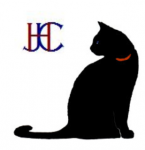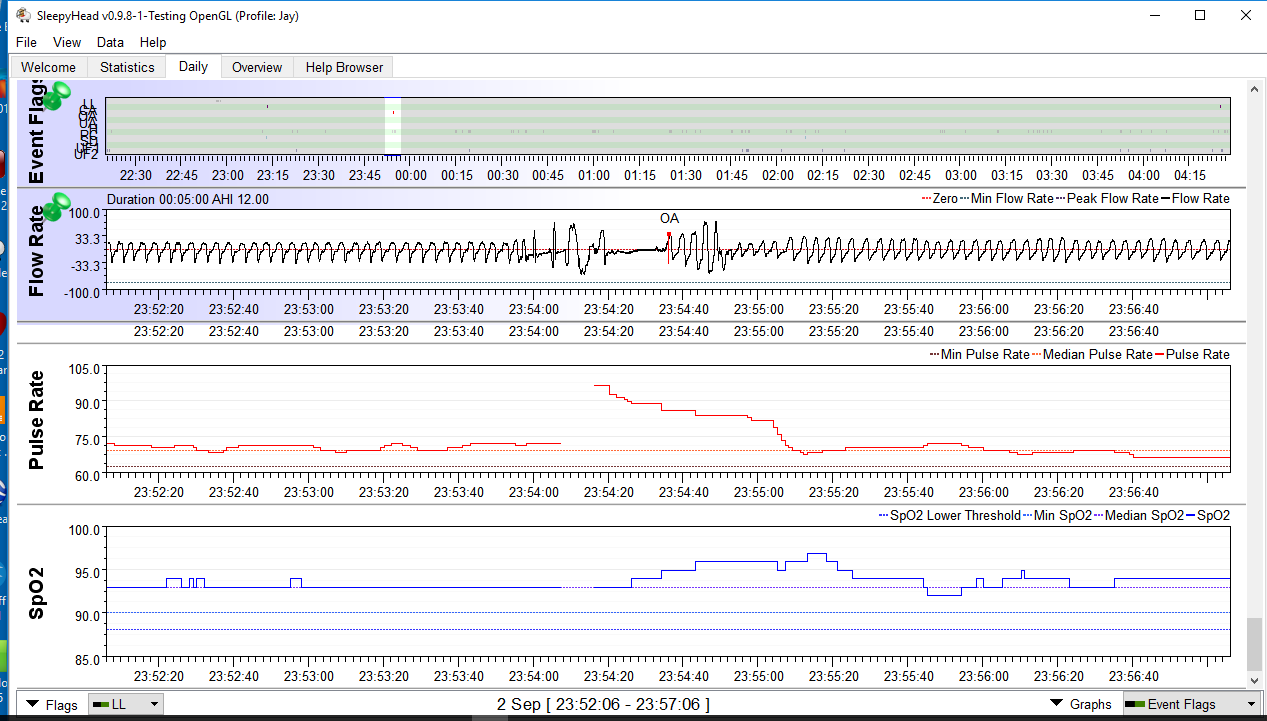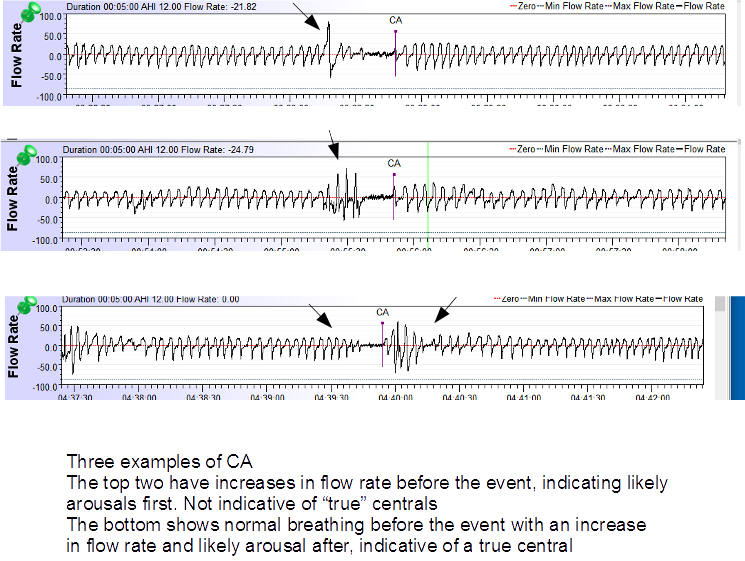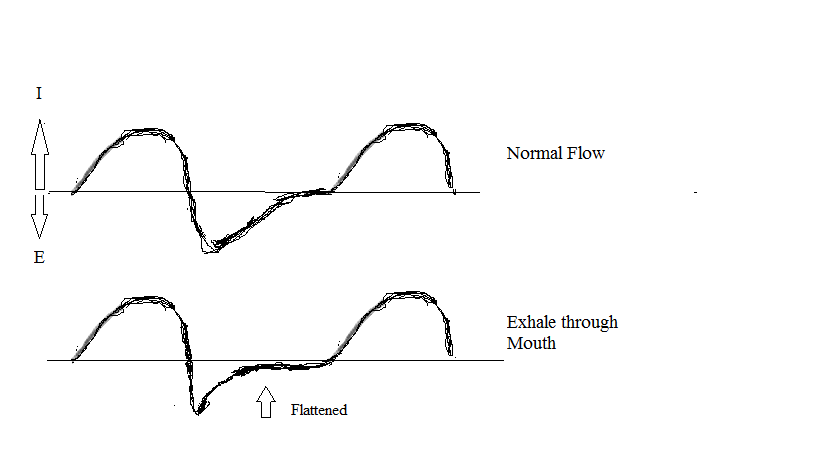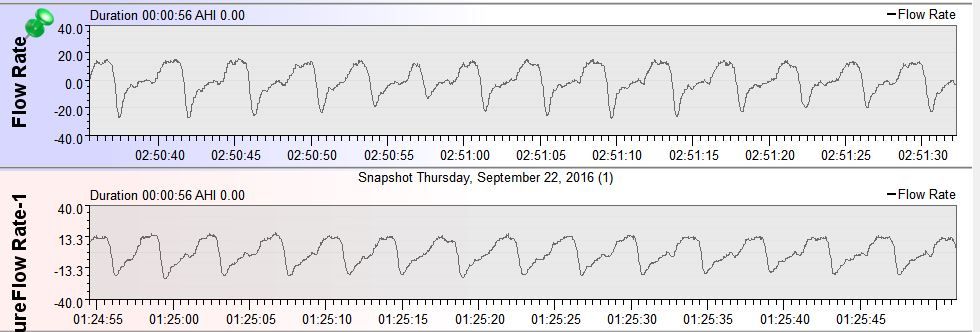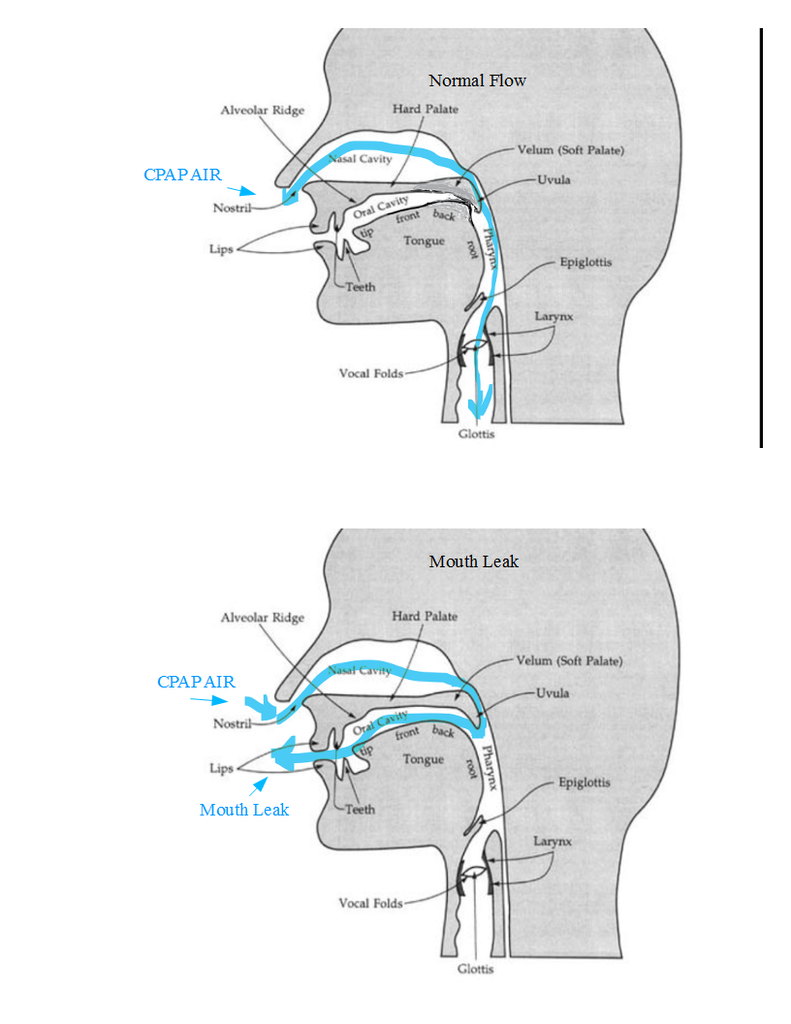Nasal Mask Waveforms: viewtopic.php?f=1&t=113502&p=1095402#p1095379
Sleep Wake Junk: viewtopic.php?f=1&t=113409&st=0&sk=t&sd=a#p1094245Jay Aitchsee wrote:This image contains examples of the various kinds of breathing that can be done while wearing a Nasal Mask. Flow Rate waveforms generated while wearing a nasal mask can be confusing. Flow Rate is just that, the machine is measuring the Rate of Flow past the sensor which is located in the machine remotely from the patient. With a nasal mask, the only Flow the machine can measure directly is that which flows through the hose into or out of the nose. Flow that enters or leaves the lungs by way of the mouth can not be measured directly because the hose is not attached to the mouth. So with a Nasal Mask, Flow Rate means Nasal Flow Rate, we are looking at the Nasal Flow (which BTW, includes leaks through the nose and out the mouth, or around the edges of the mask).
Below we see how the inability to directly sense mouth flow affects the shape of the Flow Rate Waveform. The sample is about 8 minutes long, done when I was awake and runs through a series of nasal/oral breathing combinations. The zoomed portions are about 1 minute in length and run consecutively starting at about 16:15 to about 16:20.
- From the top, in order:
- Flow Rate : The Sample Segment
Flow Rate 1: Nose In, Nose Out; Normal Breathing;
Flow Rate 2: Nose In, Mouth Out; Commonly seen
Flow Rate 3: Mouth In, Mouth Out; Flat line. The machine is unable to sense approximately 12 breaths and scores a 47 second apnea. Occasionally seen as a break in therapy.
Flow Rate 4: Mouth in, Nose out; seen often as a flat line between two exhales, an inhale by mouth.
- From the top, in order:
- Flow Rate : The Sample Segment
Flow Rate 1: Nose In, Nose Out; Normal Breathing;
Flow Rate 2: Nose In, Mouth Out; Commonly seen
Flow Rate 3: Mouth In, Mouth Out; Flat line. The machine is unable to sense approximately 12 breaths and scores a 47 second apnea. Occasionally seen as a break in therapy.
Flow Rate 4: Mouth in, Nose out; seen often as a flat line between two exhales, an inhale by mouth.
Mouth Leaks with a Nasal Mask: viewtopic.php?f=1&t=112758&p=1085906#p1085906Jay Aitchsee wrote:People often ask, "what about all these CAs?" And the reply is often that it looks like Sleep Wake Junk (SWJ). Sleep Wake Junk is characterized by irregular Flow Rate waveforms followed by a CA's or sometimes OA's. It is most often seen in the early morning hours.
Some examples below. These are NORMAL waveform segments. The the OA's and CA's would not count toward AHI in a lab sleep study.
***********************************************
Below is an example of a disturbance or arousal of unknown origin.
The machine scored a 16 second Obstructive Apnea (OA); however, we can see that there is sharp increase and irregularity in the Flow Rate Waveform immediately preceding the event, indicating a likely arousal. Additionally, we can see that the pulse rate and the oxygen level actually increase during the event. With an actual OA, it would be typical to see the O2 fall during the event and then rise with an increase in pulse after.
Likely, I changed positions or rolled over and held my breath for 16 seconds while doing so. The small break in the Pulse Oximeter trace reinforces the supposition that this was movement related.
This event would not be scored as an OA in a lab sleep study.
***********************************************
CA Examples:
Jay Aitchsee wrote:Flow wave examples of mouth breathing wearing a nasal mask:
23:43:30 to 23:44:00 Normal Breathing; Nose In, Nose out.
23:44:00 to 23:44:44 Total Mouth Breathing; Mouth in, Mouth out. 44 second apnea scored at resumption of nasal breathing, no leaks scored.
23:44:50 to 23:45:20 Exhalation by Mouth: Nose in, mouth out, scoring a leak of about 8L/min
Note: With a nasal mask, Flow is only that which passes through the hose connected to the nose. The machine can not directly measure any flow through the mouth. The machine determines leak by measuring the outflow compared to the inflow. If outflow is greater than inflow, ignoring mask vent rate, there is a leak. When exhaling through the mouth, some outflow is lost (to the hose) and the machine scores a leak. When inhaling through the mouth, inflow from the machine is reduced or stopped and the machine registers an apnea.
************************************************************************
Below:
Normal sleep breathing on top, expiratory mouth breathing on the bottom in large leak (shaded area)
Notice the flattening of the expiratory portion of the wave with exhalation by mouth.
Edit: Times corrected
*************************************************************************
*************************************************************************
Knowing whether leaks are from the mouth or mask could be helpful. The sample below contains two sets of flow waves from the same night taken during periods of over threshold high leak as indicated by the shade. The expiratory portion of the top set has the rapid rise and relatively flat run typical of a mouth leak. The bottom sample does not.
Since the over threshold leak is present with or without mouth leaks, I can assume it to be a mask leak and my pillows or headgear need attention.
*************************************************************************
Classic mouth leak plateau shaped waveforms
Mouth Leaks Defined: Patent ApplicationIn some cases, pressurized air flows through the velopharyngeal sphincter (i.e. between the lateral pharyngeal walls and the soft palate) into the oral cavity and then out through the lips, resulting in a mouth leak. When a mouth leak occurs, pressurized air does not reach the lungs and does not contribute to ventilation, thereby rendering the treatment less effective or ineffective. In addition, because of the one-way airflow through the nasal passages, mouth leaks tend to dry the mucosal surfaces resulting in nasal congestion after only several hours of use. In some applications, the CPAP system will apply a higher pressure through the nose mask when a mouth or mask leak is detected to compensate for the leak which only exacerbates the problem. In many cases, the side effects are often so severe that the patient is no longer able to tolerate treatment.








